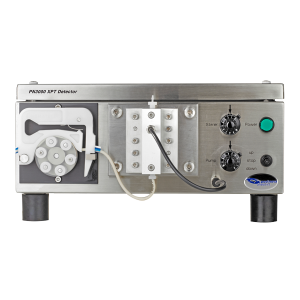PN3000 XPT - Micro Particle Detector
The Postnova PN3000 XPT Online Particle Size Detector is a new type of detection system which combines optical particle sizing with advanced CCD detection and fast image analysis. The system is ideal for coupling to FFF and enables the online identification and characterization of microparticles. Any kind of FFF separation system, such as Splitt, Centrifugal, Flow or Thermal FFF, can be hyphenated to the PN3000 XPT. The detector employs a special inert glass flow cell which is illuminated by a LED light source coupled with sensitive CCD detection for the optical identification and characterization of any microparticle from approximate 1 µm up to 300 µm. Thus, in combination with a FFF separation system, even the most complex particle systems can be characterized. The particle size and number, size distribution and shape can be easily obtained for each fraction. This makes the technology ideal for use in Pharmaceutical Technology, Biotechnology, Chemical and Environmental applications.
Unique working Principle and Features
Avoiding the pitfalls of other commonly used online particle size detectors based on static light scattering, the PN3000 XPT is truely the first real online detector for microparticle sizing connected to FFF and SPLITT separation systems.
The detector allows online measurement of Particle Size, Particle Counts, Particle Shape and Particle Color Intensity Change by an innovative online image analysis as the particles pass through the flow cell. A high resolution CCD camera with 1024 x 768 Pixel and an extremely short shutter for sharp images of fast moving particles is the core of the system. The software platform is used for automatic online image aquisition, particle size and shape analysis, trend display, storage of analysis methods and automatic saving of images depending on predefined criteria.
Applications:
- Particle-sizing
- Particle-counting
- Particle-shape detection
- Particle-volume calculation
- Particle-color density detection
- Particles, droplets or bubbles in liquid
- Online counting of product beads into vials
- Fibre counting within irregular shaped particles
- Measurement of shape changes of grinding particles
- Microparticle detection in highly concentrated nanoparticle solutions
- General food, pharma, polymer, chemical and environmental applications
Software:
In the „Development Window“ the master user is setting-up and testing methods. A method consists of three sub-methods: Camera Method (lighting, region of interest), Filter Method (contrast enhancement, inverting, subtraction of background) and Analysis Method (measurement range, filtering particles by size or shape). All methods are saved independently. Result files are saved in a non-changeable format for completely compliance of software with 21CFR Part 11 regulations.
Sample Cell
Flow through cell with 160 µL detection volume
Cell completely inert made from quartz glass
Maximum pressure tolerance up to 10 bar
Measurement Range
From 1 µm up to 300 µm
Maximum resolution 0.3 µm/Pixel
Typical Flow Rates
Range from ca. 0.5 mL/min to approx. 5 mL/min
Outer dimensions
380 x 300 x 120 mm
Case material
stainless steel
Camera
1024 x 768 Pixel
Power supply 115/230 V
Detection Principle
Optical CCD detection using online image analysis
Precision of Particles Size
±0.3 µm limited by CCD and optical lense resolution
Light Source
Special high intensity LED
Light Source Life Time
Approx. 10,000 hours
Solvent Compatibility
All commonly used aqueous and organic solvents
Electronics/Communications
Out-put signal of online particle size
Software selectable event out-put signal
Camera with 1024 x 768 Pixel
PC:
Pentium 4.3 GHz – PC
Notebook, IP65
Shipping Weight
ca. 12.5 kg
Power requirement
230/110 V, 50/60 Hz


